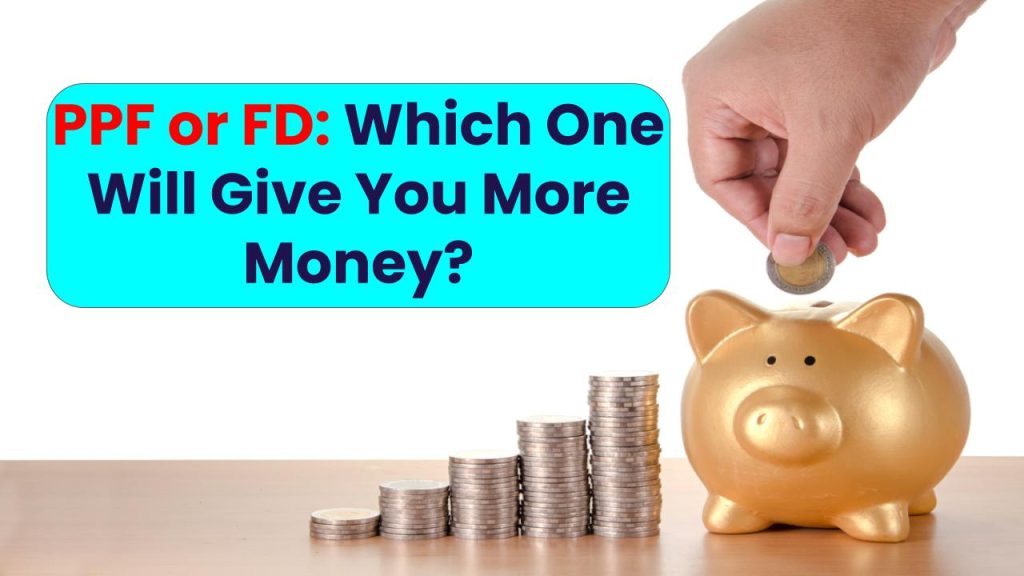
Are you wondering “PPF or FD, which one will give you more money if you invest for 15 years?” You’re not alone. Whether you’re planning long-term savings or looking for a safe investment avenue, this question often pops up. Both Public Provident Fund (PPF) and Fixed Deposits (FDs) are popular choices, but which one is better for your financial goals?
PPF or FD, Which One Will Give You More Money
| Feature | Public Provident Fund (PPF) | Fixed Deposit (FD) |
|---|---|---|
| Interest Rate | 7.1% per annum (Q1 FY 2025-26, subject to periodic change) | 5% to 7.5% per annum (varies by bank & tenure) |
| Compounding Frequency | Annually | Quarterly or Annually |
| Investment Tenure | 15 years (mandatory lock-in) | 7 days to 10 years (flexible) |
| Tax Benefits | Under Section 80C, tax-free interest & maturity | Under Section 80C (only tax-saving FDs); interest is taxable |
| Liquidity | Partial withdrawals from 7th year onwards | Premature withdrawal allowed with penalty |
| Risk Factor | Government-backed, extremely low risk | Low risk, bank-backed |
So, PPF or FD, which one will give you more money if you invest for 15 years? The answer lies in your financial goals, tax preferences, and need for liquidity. For tax-free, long-term growth, PPF is the clear winner. However, if you need more flexibility and quicker access to funds, FDs offer better liquidity despite tax implications.
What is Public Provident Fund (PPF)?
Public Provident Fund (PPF) is a government-backed long-term savings scheme designed to encourage small savings while offering tax benefits. It has a mandatory lock-in period of 15 years, making it ideal for those who want to invest for the long haul without touching their money.
Key Features of PPF:
- Interest Rate: Currently at 7.1% per annum, compounded annually (Q1 FY 2025-26).
- Tax Benefits: Full tax exemption on the investment (under Section 80C), interest earned, and maturity amount.
- Minimum Investment: ₹500 annually.
- Maximum Investment: ₹1.5 lakh annually.
- Risk: Backed by the Government of India, ensuring zero risk.
Example: If you invest ₹1.5 lakh every year in PPF for 15 years at 7.1%, you will accumulate around ₹40.68 lakh at maturity, and no tax will be deducted.
see also: Know These 3 Major Losses Before Doing a Bank FD or Else You Will Regret It
What is a Fixed Deposit (FD)?
Fixed Deposits (FDs) are savings instruments offered by banks and financial institutions. You deposit a lump sum amount for a fixed tenure and earn a fixed interest rate on it.
Key Features of FD:
- Interest Rate: Varies from 5% to 7.5% per annum, depending on the bank and deposit tenure.
- Tax Benefits: Only tax-saving FDs (5-year lock-in) qualify for Section 80C benefits; however, interest is fully taxable.
- Minimum Investment: Generally starts at ₹1,000.
- Tenure: Flexible, from 7 days to 10 years.
- Liquidity: Premature withdrawal allowed but may incur penalties.
Example: If you invest ₹1.5 lakh in an FD at 7% compounded quarterly for 15 years, you will receive approximately ₹41 lakh, but the interest earned will be subject to tax.
Detailed Comparison: PPF vs FD Over 15 Years
1. Returns Over 15 Years
| Investment | PPF (7.1% annually, tax-free) | FD (7% quarterly compounding, taxable) |
|---|---|---|
| ₹1.5 lakh/year | ₹40.68 lakh (approx) | ₹41 lakh (approx before tax) |
Verdict: While FD may offer slightly higher gross returns in some cases, after tax deductions, PPF usually yields better net returns.
2. Tax Benefits
- PPF: Triple tax exemption (EEE – Exempt-Exempt-Exempt). No tax on principal, interest, or maturity.
- FD: Tax-saving FDs allow for principal deduction under Section 80C, but interest is taxable as per your slab.
Professional Insight: For individuals in higher tax brackets (20%-30%), PPF offers significantly better tax efficiency.
3. Liquidity & Premature Withdrawal
- PPF: Partial withdrawals allowed after 7 years. Full amount withdrawable after 15 years.
- FD: Premature withdrawal anytime, subject to penalty (0.5%-1% reduction in interest rate).
Professional Tip: If you anticipate needing funds before 15 years, FDs provide better liquidity.
4. Risk & Security
- PPF: 100% safe, backed by the Government of India.
- FD: Safe, but limited to ₹5 lakh deposit insurance per depositor per bank by DICGC.
see also: Loan Against FD: Everything You Need to Know Before Borrowing
Which One Should You Choose?
| Profile | Best Option |
|---|---|
| Long-term investor seeking tax-free growth | PPF |
| Investor needing flexibility & short-term access | FD |
| High-income taxpayer aiming to save on tax | PPF |
| Conservative investor looking for stable returns | Both, but diversify between PPF and FD to balance liquidity & tax advantage. |
PPF or FD FAQs
1. Can I invest in both PPF and FD simultaneously?
Yes, you can invest in both. Many professionals recommend splitting investments to enjoy the benefits of both schemes.
2. Is there any age limit to open a PPF account?
No, anyone can open a PPF account. Even minors can have accounts opened in their name by their parents or guardians.
3. How is FD interest taxed?
FD interest is added to your total income and taxed as per your income tax slab. Banks deduct TDS if interest exceeds ₹40,000 (₹50,000 for senior citizens).
4. Can I take a loan against my PPF account?
Yes, loans can be availed against the PPF balance between the 3rd and 6th year of account opening.
5. Are PPF returns fixed?
No, PPF interest rates are reviewed quarterly by the government. However, they are generally stable and above inflation.











